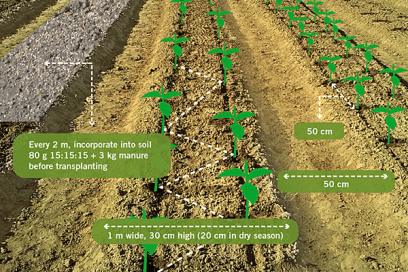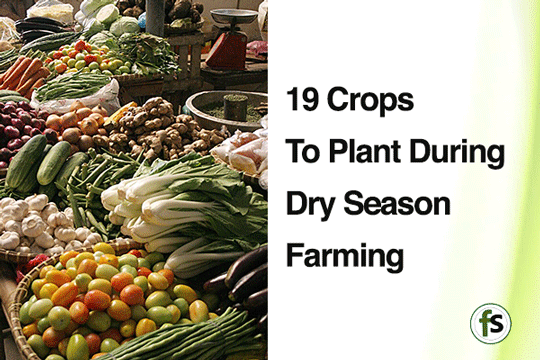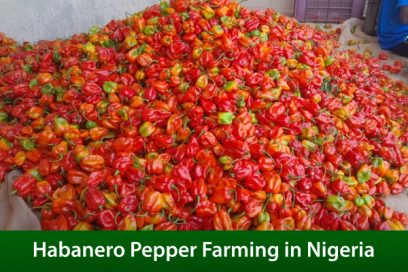- You have no items in your shopping cart
- Subtotal: ₦0
Dry season farming crops…
As we all know, the rainy season is gradually going. This does not mean you stop farming. Many people have been asking what type of crops they can grow during the dry season. NiMet Predicted Rain Will Drop By November, 2021.
One of the best ways to ensure food security in any country is to guarantee all year-round food supply. However, local farmers across the country often complain that unpredictable rainfall is the cause of low crop yields and food shortages. This is usually common in the dry season, when the average rainfall is less than 60 mm. Limited rainfall, together with a lack of available water resources, have led to high prices for many agricultural products during the dry season.
During dry season, crops require water and most farmers tend to wait for rainy season to plant them. It’s important to have a source of water for crops you decide to cultivate. Your source of water could be well, stream, and irrigation system.
One main benefit of dry-season farming is that it helps reduce the country’s dependence on imports and thus ensures food security. The disadvantage is that it requires extra efforts especially when planting on a large scale. In addition, soil salinization and flooding can occur during planting in the dry season.
Make sure you read and digest to the end.
Here are 19 dry season crops to cultivate;
You can grow any crop during this season. To be profitable, the timing and management you give will determine if you will make profit or not.
Dry season farming crops;
1. Capsicum
2. Onions
3. Tomatoes
4. Cabbage
5. Ugu
6. Rice
7. Ewedu
8. Maize
9. Cotton
10. Carrots
11. Cucumber
12. Okra
13. Egg plant
14. Melon
15. Spinach
16. Sweet potato
17. Sweet corn
18. Green beans
19. Yam (in jute bags)
1. Capsicum
Capsicum is a type of vegetable, commonly known as sweet pepper. It’s used as spice. You can grow it in greenhouses and open terrain. It usually come in various varieties and forms. Capsicum has a wide range of nutritional benefits as it provides a rich source of vitamins and alkaloids, has anti-inflammatory and analgesic effects so it can be used as an antioxidant. If you planted about 5,000 to 10,000 peppers in an acre of land, after a growth period of 90 days, your expected yield would exceed 5-20 tonnes.
Some sweet pepper varieties grown in Nigeria;
These varieties have a primary green color. However, as they mature, some will form different colors like yellow, red etc.
Land preparation
The soil must be carefully prepared by ploughing and harrowing until a clean, fine soil is obtained. Spray a non-selective systemic herbicide with Glyphosate to remove broadleaf and herbaceous weeds on the field.
Fertilizer Application
Where the land is very fertile, it may not need fertilizer. In less fertile soils, however, you can fertilize about two weeks after planting. Choose the right fertilizer.
2. Onions
Onions are a staple of many soups, salads and stews. They are part of the Allium family and come in many varieties, including green onions, dry bulb onions and the white onions. It takes about 4 months for the onions to ripen, which is a viable business for farmers. Through good management practices, a yield of 20-25 tons per hectare can be obtained. Before now, in Nigeria, onions are mainly grown in Kano, Kaduna, Jigawa, Sokoto, Plateau, Bauchi and Kebbi states.
The health benefits derived from onions include strengthening the body’s immunity by providing vitamins, it contains chromium, which helps regulate blood sugar, and for many years it has cured infections by reducing inflammation.
Some onion varieties grown in Nigeria;
Land Preparation: Plough and harrow your farmland to have a uniform seedbed. Add manure few weeks before sowing. 8-10 kg of seeds are enough for the cultivation of one hectare.
Fertilization requirements: Onions respond very well to organic compost. It is recommended to use 25 to 40 tons / ha of organic fertilizer to obtain high yield bulbs. Apply approximately and recommended NPK fertilizers.
3. Tomato
Tomatoes are one of the favorite food crops of Nigeria’s backyard farming. It’s one profitable agribusiness you can easily venture into without much risk. Tomato fruits are rich in antioxidant, has vitamins A, C etc. To maximize production, you may need to set up irrigation system to maintain an even moisture supply to the crop.
Tomato fertilizer application chart by East-West Seed Foundation

The image below shows the recommended spacing and how to plant tomato according to East-West Seed Foundation. Narrow paths help with irrigation and drainage. Install trellis 8-10 days after transplanting. 26,600 plants/ha.

Some tomato varieties grown in Nigeria;
Read more >>> Tomato Farming
4. Cabbages
Cabbage is a green leafy biennial plant in the broccoli family that is farmed all year. After transplanting, it takes two to three months for the plant to mature. It is thus adaptable for any farmer to invest in in order to reap multiple rewards in a short period of time. Cabbage is high in Sulphur, which is essential for healthy hair, nails, and skin.
It is low in fat and high in fiber, making it an excellent choice for weight loss. The vegetable is high in vitamin C, which detoxifies the body, as well as chemicals that boost enzyme activity and inhibit dangerous tumor growth. Cabbage production per acre is between 11,000 and 15,000 heads.
How do you get your land ready for cabbage?
The land should be clean and cultivated for at least 8 weeks prior to planting. The ground must be ploughed to a depth of 450 to 600 mm with a disk harrow or other suitable equipment immediately before planting. If necessary, the soil should be fumigated 2 weeks before planting to control nematodes.
What is the best fertilizer for cabbage?
Cabbage is a heavy feeder that requires nitrogen, phosphorus, and potassium fertilization in the form of manure or compost. The fertilization plan must be based on the soil analysis and must be developed for each area. Cabbage needs 200 to 250 kilograms of nitrogen per hectare to grow.
Some cabbage varieties grown in Nigeria;
5. Fluted pumpkin (Ugu) leaves
These are prevalent in the markets of Benin, Nigeria, and Cameroon’s lowland districts. Intensive trade develops along river banks in Nigeria during the dry season for sale to urban areas where big food-crop markets emerge. Over 40 million people are expected to consume the leaves on a daily basis, making it one of Nigeria’s most popular vegetables. Ugu is mostly propagated through seeds.
Planting at a close spacing of 50 cm x 30 cm results in a larger population of 65,000 plants/ha. The goal is to get the most out of the limited growing season.
Land preparation can be done depending on the individual farmer’s financial capability or cultural attitude.
Fertilizer requirements: Fertilizer application rates differ depending on where you are. A pre-plant treatment of 20t/ha of poultry manure will improve Ugu. For large-scale production, it’s best to use 25-50 percent of this rate at pre-plant then top-dress with N.P.K fertilizer to get the remaining half of the nutrients needed. With two split treatments of 80-90 kg N/ha, good vine yields of around 10.0 t/ha were achieved.
Some Ugu varieties grown in Nigeria;
- Maya F1
- Dream Gold F1
6. Rice
Rice is by far the most widely consumed food in Nigeria. It is prepared in different forms, including the popular White Rice and Stew, Jollof Rice, Pounded Rice, and others. Rice’s utility in most countries around the world cannot be overstated. Rice farming has many advantages, one of which is that it takes less than four months from planting to harvest. As a result, whatever amount you invest today, you may expect a return within five months.
A month following transplanting, fertilizer is applied. Use the right fertilizer (Organic fertilizer) and apply it by spraying the correct amount of fertilizer within the plant field. One Acre of rice farm is capable of producing over 100 bags of rice. When matured, the color of the rice will change from green to light brown. Then, you know your crop is ready for harvest.
Land preparation
To reduce weed competition, proper soil preparation is required for rice production. Tilth is sufficient for rice growth after two harrowings. Ridging isn’t always essential and can be a waste of space. Minimum or no tillage is advised where soils are more fragile and prone to erosion. To destroy emergent weeds, spray the field with glyphosate at a rate of 4L/ha if zero tillage is to be used.
Some rice varieties grown in Nigeria;
- FARO 44 a.k.a SIPI
- FARO 52 a.k.a WITA 4
- FARO 61 a.k.a NERICA L-34
- FARO 59 a.k.a NERICA 8
- FARO 60 a.k.a NERICA L-19
Aside Dry season farming crops, see also
11 Crops To Plant And Harvest Within 3 Months.
7. Ewedu (Jute Leaf)
Ewedu is a high-fiber, vitamin, and mineral-rich vegetable. It has a low calorie count, making it a good choice for persons who are attempting to reduce weight. It’s also a source of lignin, which is a crucial raw element in the textile industry. One unique feature of this vegetable is that it grows almost everywhere; nevertheless, when cultivated properly on well-watered land, it grows quickly and has a high yield.
Land preparation: Ewedu prefers a loamy, well-drained soil with enough of organic content. It grows well in locations with a moderate amount of rainfall. Eewedu, on the other hand, can be planted at any time of year as long as irrigation facilities are available. The land should be tilled to soften it before planting. Root development and growth are aided by a well-pulverized soil. One acre of Ewedu (Jute leaf) can yield a profit of N500,000.
One top secret and somewhat uncommon feature of this vegetable known as Ewedu is that you must parboil the seeds before planting them if you want them to germinate quickly; otherwise, it could take months to sprout, defeating the purpose of growing it at all. During the wet season, a quantity sold for N100 might cost between N1,500 and N2,500 during the dry season! If properly watered, Ewedu can last between one and one and a half months before harvesting.
Dry season farming crops To be continued…
Where to obtain quality and improved seeds;
- Seed Companies.
- Agricultural Officer or Extension Worker.
- River Basin Development Authority.
- State Agricultural Development Project.
- Branch officer of the National Agricultural Seeds Council.
- Research Institutes.
- Farmsquare Agricultural Company Limited (08135196537, 07049089805)
Conclusion
One thing to keep in mind before cultivating dry season farming crops is to make sure you check for crops that have a ready market and high demand in your area. Currently, a cucumber and pepper bag costs about #8,000 and #9,000 respectively. A bag of pepper might cost #20,000 by February.




Lovely post thtank you